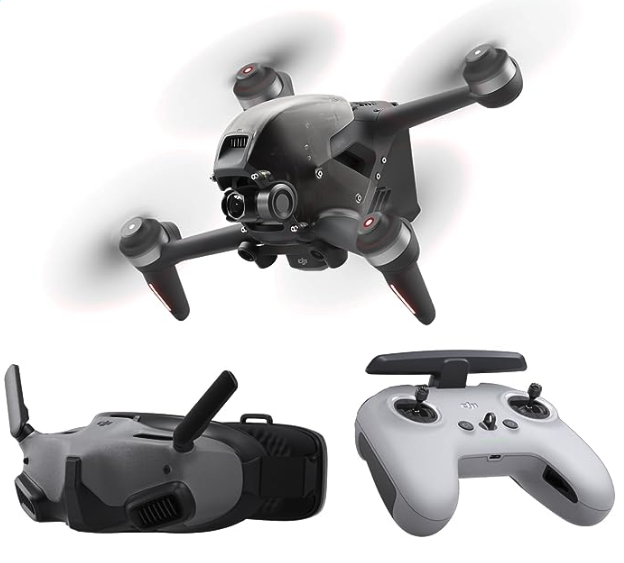Choosing Your First FPV Drone: An In-Depth Guide for Beginners
Contents
Introduction to FPV Drone Selection
Understanding FPV Drone Acronyms
Components of FPV Drones
Factors to Consider When Choosing Your First Drone
Types of FPV Drones
Ready-to-Fly (RTF) vs Building Your Own
Understanding FPV Drone Motors
Battery Sizes and Understanding the 1-8S Rating
Receiver (RX) Protocols
FPV Drone Video Transmitters (VTX)
Where to Buy Your FPV Drone
Final Thoughts
Additional Resources
INTRODUCTION TO FPV DRONE SELECTION
If you're venturing into the world of FPV (First Person View) drones, choosing your first drone can be an exciting yet daunting task. Unlike purchasing a standard DJI drone where you can start flying right away, FPV drones come with a range of complexities and customization options. We are strictly going to be talking about digital systems as I think analog will be on it’s way out in the next 5-10 years. In this guide, I'll walk you through everything you need to know about selecting your first FPV drone.
UNDERSTANDING FPV DRONE ACRONYMS
FPV drone terminology can be overwhelming at first, but understanding these acronyms is crucial. You will see these when you are browsing for your first drone. Here are some key terms:
RTF: Ready-To-Fly
BNF: Bind-N-Fly
PNP: Plug-N-Play
KIT: Requires assembly, no electronics
FC: Flight Controller
ESC: Electronic Speed Controller
VTX: Video Transmitter
RX: Receiver
TX: Transmitter
OSD: On-Screen Display
COMPONENTS OF FPV DRONES
FPV drones are made up of several key components, each playing a vital role in the drone's performance:
Motors: They determine the power and speed of the drone.
Flight Controllers: Act as the 'brain' of the drone, controlling its stability and responsiveness.
Frames: The structural skeleton of the drone, affecting durability and flight characteristics.
Electronic Speed Controllers (ESCs): Regulate the power to the motors and thus control the speed and direction of the drone.
Propellers: Influence the lift and maneuverability of the drone.
Batteries: Provide the necessary power to the drone. The choice of battery affects flight time and overall performance.
FPV Camera: Captures real-time video, providing the pilot with a drone's-eye view.
Video Transmitter (VTX): Sends the video signal from the FPV camera to the goggles or monitor.
FPV Goggles or Monitor: Allow the pilot to view the live stream from the FPV camera.
Receiver (RX): Receives the control signals from the transmitter (remote control) and communicates them to the flight controller.
Transmitter (TX): The remote control used by the pilot to control the drone.
Antennas: Essential for transmitting and receiving clear video and control signals.
3D Prints: Custom parts for personalization, protection, and added functionality.
Soldering Skills: Necessary for assembling and repairing the components.
Power Distribution Board (PDB): Distributes power from the battery to the various components of the drone.
On-Screen Display (OSD): Provides in-flight data such as battery voltage, flight time, and signal strength, overlaid on the FPV feed.
Flight Control Software/Firmware: Software that runs on the flight controller, affecting how the drone responds to control inputs.
FACTORS TO CONSIDER WHEN CHOOSING YOUR FIRST DRONE
Purpose of Flying
The purpose behind your FPV drone flying plays a significant role in choosing the right model. If you're interested in racing, you'll want a drone that is fast, agile, and capable of quick maneuvers. For freestyle flying, look for drones that offer stability and are resilient to withstand various tricks and flips. Meanwhile, if your focus is on cinematic flying, drones that can carry high-quality cameras and provide stable, smooth footage are ideal. Each of these flying styles requires different features from a drone, so it's important to identify your primary interest before making a selection.
Size and Portability
The size of the drone is another crucial factor to consider. Size options range from tiny 'whoop' drones, perfect for indoor flying and beginner pilots, to larger outdoor models that offer more power and robustness. Smaller drones are generally more portable and easier to handle, making them great for casual flying and practice. On the other hand, larger drones, while less portable, typically offer advanced features and capabilities, suitable for more serious enthusiasts or professional use. Your choice should reflect where and how you plan to use your drone most frequently.
Budget
Budget considerations are key when selecting your first FPV drone. It’s not just about the cost of the drone itself; you should also consider the price of additional equipment such as spare batteries, replacement parts, a good quality controller, FPV goggles, and possibly a camera. Setting a budget can help narrow down your options and keep your expenses in check. Remember, starting with a more affordable model might be wise, as there's always a learning curve that might involve a few crashes and repairs.
Skill Level
Your skill level is an important aspect to think about when choosing an FPV drone. If you are a beginner, it’s recommended to start with a user-friendly drone that is easy to control and forgiving of mistakes. These drones often come with features that help new pilots, such as stabilized flight modes or built-in safety functions. As you gain more experience and confidence, you can graduate to more advanced models that offer greater speed and maneuverability. The key is to choose a drone that matches your current skill level but also allows room for growth and learning.
TYPES OF FPV DRONES
Freestyle Drones: Agile and perfect for tricks and maneuvers.
Cinewhoops: Great for cinematic footage, stable, and usually safer.
Racing Drones: Built for speed and competitive flying.
READY-TO-FLY (RTF) VS BUILDING YOUR OWN
RTF Drones: Great for beginners, as they require minimal setup.
Building Your Own: Offers customization and a deeper understanding of the mechanics. Requires more time and potentially more skills.
Understanding FPV Drone Motors
When selecting an FPV drone, understanding motor sizes is crucial. The size of a motor is typically indicated by a set of numbers like '2207' or '2306'. The first two numbers (e.g., 22 or 23) represent the diameter of the motor in millimeters, while the last two numbers (e.g., 07 or 06) indicate the height of the motor's stator, also in millimeters. Larger motors can generate more thrust but may also consume more power, affecting your drone's battery life.
The choice of motor size affects the overall performance of the drone, including its speed, agility, and how it handles. For racing drones, pilots often prefer larger and more powerful motors for speed and quick acceleration. In contrast, for cinematic or freestyle flying, pilots might choose motors that offer a balance between power and efficiency to allow for smoother and more controlled movements.
Battery Sizes and Understanding the 1-8S Rating
The battery is a key component that powers your FPV drone. Batteries are rated with a "S" number, like 1S, 2S, 3S, up to 8S. This number refers to the number of cells in series in the battery. Each cell has a nominal voltage of 3.7 volts, so a 3S battery has a nominal voltage of 11.1 volts (3.7V x 3).
Higher "S" ratings mean more power and longer flight times but also increased weight and cost. For example, a 1S battery is lightweight and typically used in smaller drones, while a 6S or 8S battery would be found in larger, more powerful models.
Your choice of battery will depend on the drone's motor and ESC specifications, as well as your desired balance between flight time and performance. Most drones you will likely be looking at are 4S batteries. It's important to choose a battery that matches your drone's requirements to ensure optimal performance and avoid damage.
Receiver (RX) Protocols
FPV drones utilize various receiver protocols to communicate between the drone and the transmitter, each offering unique features. The most common protocols include FrSky, Crossfire, DJI, and ELRS (ExpressLRS). Understanding these can help you choose the best option for your needs.
FrSky: FrSky is popular among hobbyists due to its balance between range and latency. It provides reliable performance and is commonly used in both racing and freestyle drones.
Crossfire (TBS): The Crossfire system from Team BlackSheep is renowned for its long-range and low latency, making it ideal for advanced pilots, long-range flying, and situations where signal reliability is paramount.
DJI (PNP): DJI's proprietary protocol is known for its high-quality video transmission and low latency control. It's especially popular in cinematic and professional drone setups. DJI's system often integrates both control and video transmission into a single solution, which is highly beneficial for FPV flying with a focus on video quality.
The choice of receiver protocol will depend on various factors such as your flying style (racing, freestyle, cinematic), experience level, budget, and preference for features like range, latency, and video transmission quality. Pilots who prioritize performance and customization might lean towards ELRS or Crossfire, while those focusing on high-quality FPV video might prefer DJI. I use DJI in all my FPVs and may switch to ELRS soon.
FPV Drone Video Transmitters (VTX)
Digital VTX systems, like the ones offered by DJI, have revolutionized FPV flying by providing crystal-clear HD video feeds. There are no other digital systems like Walksnail, but DJI still reigns supreme. These systems are favored for cinematic and professional applications due to their superior image quality and robust signal. The trade-off typically comes in the form of higher cost and slightly higher latency compared to analog systems, so if you want to get into racing drones then analog is typically the move.
I like the GEPRC Cinebot30 over the DJI FPV, but you will have to buy the DJI RX and TX separately.
WHERE TO BUY YOUR FPV DRONE
There are numerous online retailers and hobby shops where you can purchase FPV drones. Look for stores with good customer support and community recommendations.
DJI FPV Explorer Combo - $999
DJI Controller 2 - $189
DJI Goggles 2 - $615
Popular Retailers
FINAL THOUGHTS
Choosing your first FPV drone is a personal journey that depends on your interests, budget, and willingness to learn. Don't rush the process – take your time to research and make an informed decision.
ADDITIONAL RESOURCES For more in-depth information, consider joining online forums, FPV drone communities, and following FPV influencers for tips and advice. Remember I do offer custom mentorships for one-on-one and guidance.



